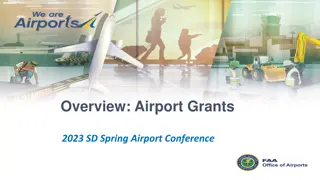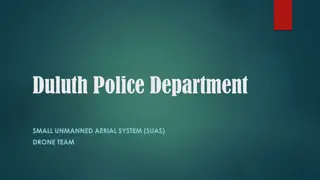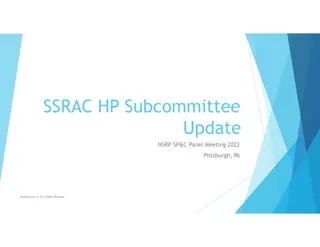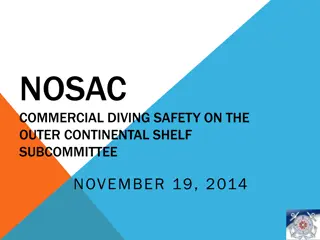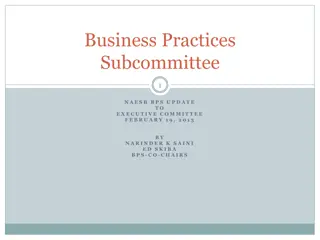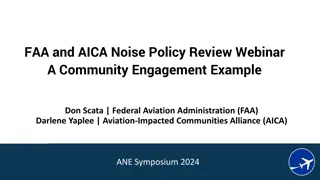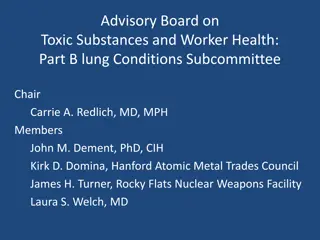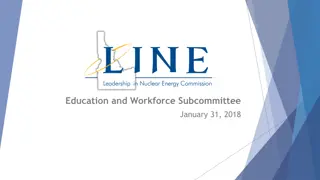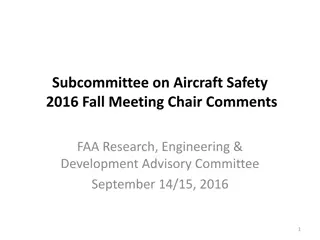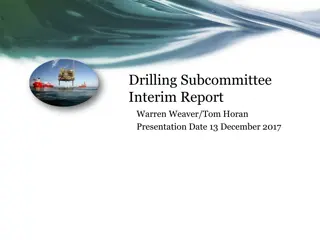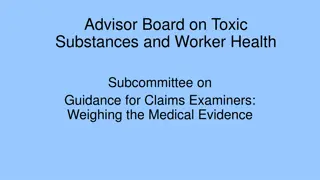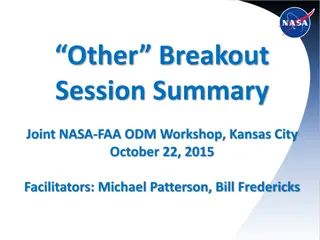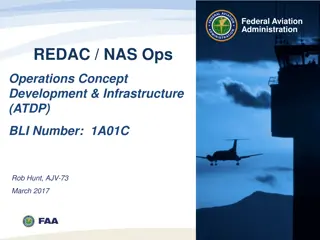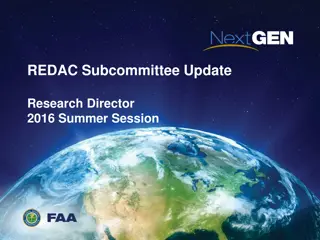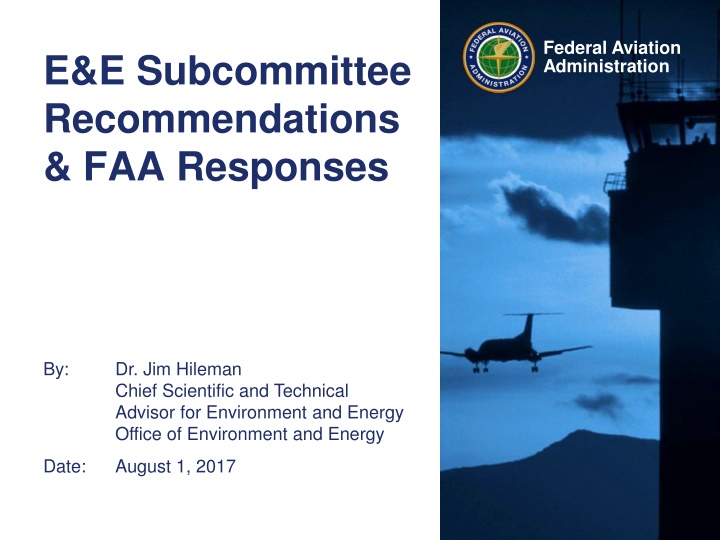
FAA Subcommittee Recommendations & Responses - Environment and Energy
In this update, Dr. Jim Hileman discusses the progress, findings, and responses related to aviation noise research and the development of key tools for environmental analyses. The Federal Aviation Administration's actions and plans in response to subcommittee recommendations are outlined for improved public outreach and enhancement of the Aviation Environmental Design Tool.
Download Presentation

Please find below an Image/Link to download the presentation.
The content on the website is provided AS IS for your information and personal use only. It may not be sold, licensed, or shared on other websites without obtaining consent from the author. If you encounter any issues during the download, it is possible that the publisher has removed the file from their server.
You are allowed to download the files provided on this website for personal or commercial use, subject to the condition that they are used lawfully. All files are the property of their respective owners.
The content on the website is provided AS IS for your information and personal use only. It may not be sold, licensed, or shared on other websites without obtaining consent from the author.
E N D
Presentation Transcript
Federal Aviation Administration E&E Subcommittee Recommendations & FAA Responses By: Dr. Jim Hileman Chief Scientific and Technical Advisor for Environment and Energy Office of Environment and Energy Date: August 1, 2017
Outline Meeting Dates Recommendations from March 2017 Action Item Status Federal Aviation Administration 2
Meeting Dates March 7-8, 2018 Washington DC - GAMA Please fill out poll for August 2018 meeting dates Federal Aviation Administration 3
2017-03 REDAC Recommendation - 1 Finding (1): Noise research is making substantial progress in studies related to the understanding of impact of aviation noise on annoyance, sleep, health, and children s learning and in the planning of studies related to noise from supersonic aircraft, Unmanned Aerial Systems (UAS), and commercial space. Some of the impacts of noise have become barriers to the implementation of NextGen. DRAFT Recommendation (1): Since the results of some of these studies will generate significant public interest, the subcommittee recommends the FAA prepare a public outreach plan to proactively manage this public interest. Response (1): The FAA concurs with the Committee s finding and recommendation and is undertaking the following actions to address its recommendation. Noise continues to be our number one environmental issue and we appreciate the Subcommittee s continued support of our research efforts to address it. We agree with the need to effectively handle the roll-out of results from the aviation noise research roadmap. We have completed the airport community noise survey. This is a key component of our aviation noise research roadmap that is eagerly anticipated by our stakeholders. To facilitate the dissemination of results from the noise survey as well as our other noise research efforts, we are developing a public outreach plan to communicate noise issues more effectively using new and innovative ways to engage the public. Federal Aviation Administration 4
2017-03 REDAC Recommendation - 2 Finding (2): In response to the action from the last subcommittee meeting, FAA provided clarity on improvements and further development needs for the Aviation Environmental Design Tool (AEDT). This will enable enhanced usability, improved airspace and airport design, continued support for analyses that support domestic and international decision-making. The FAA also identified key risks to AEDT development (e.g. availability of BADA 4 on airplane performance and noise) and has developed appropriate contingency plans. DRAFT Recommendation (2): The subcommittee supports the simultaneous development of usability improvements and enhanced features in the near term. Response (2): The FAA concurs with the Committee s finding and recommendation and is undertaking the following actions to address its recommendation. We appreciate the Subcommittee s support for the continued development of the Aviation Environment Design Tool. AEDT is the required tool for domestic environmental analyses and has been at the core of our efforts to support the ICAO CAEP standard setting process. The new developments will allow AEDT to more accurately capture fuel burn in the terminal area, which is important for the benefits assessment of NextGen, and to improve AEDT s ability to calculate noise at levels below DNL 65. Based on the Subcommittee s support, we will move forward with these efforts. Federal Aviation Administration 5
2017-03 REDAC Recommendation - 3 Finding (3): In partnership with industry, the Continuous Lower Energy, Emissions, and Noise (CLEEN) Program is maturing new technologies that will continue to show significant engine and aircraft performance benefits (fuel burn and operations improvement, noise and emissions reduction). The Commercial Aviation Alternative Fuels Initiative (CAAFI) also continues to make significant progress in advancing alternative jet fuels as a private public partnership between the FAA and industry. CLEEN and CAAFI are both very successful industry/FAA cost-share programs as is the Aviation Sustainability Center (ASCENT), the FAA Center of Excellence for Alternative Jet Fuels and Environment. Three quarters of Environment and Energy research funds are generating 100% plus cost matching from non-federal partners (CLEEN, CAAFI, and ASCENT). This leverages scarce FAA R&D funds to accomplish significant advances and improvements. DRAFT Recommendation (3) The subcommittee encourages Public Private Partnerships like CLEEN, CAAFI and ASCENT programs to leverage resources and recommends that FAA should continue to prioritize robust funding for these programs. Response (3) The FAA concurs with the Committee s finding and recommendation and is undertaking the following actions to address its recommendation. We appreciate the Subcommittee s recognition that the vast majority of the Environment and Energy R&D program has been leveraging resources from the private sector via public-private partnerships. CLEEN and ASCENT account for roughly three quarters of the RE&D Environment and Energy funding. As such, three quarters of the RE&D budget is generating 100% cost share. CAAFI does not have a cost-share requirement so the non-government funds going toward it have not been tracked over time. However, the effort has considerable industry support especially from the airlines and has been successful in directing efforts across the federal government. CLEEN, CAAFI and ASCENT have all been successful because of their strong engagement with industry. We were excited to see that the work of the FAA and industry in CAAFI to advance alternative jet fuels was highlighted as a model for public-private partnerships in the UN Secretary General s 2016 report on Sustainable Transport. Federal Aviation Administration 6
2017-03 REDAC Recommendation - 4 Finding (4): The operational research program is an important and impactful program in the Environment and Energy portfolio. These projects are being worked (or planned to be worked) in collaboration with the FAA Air Traffic Organization (ATO), FAA NextGen Office (ANG), FAA Office of Airports (ARP), NASA, and MassPort. DRAFT Recommendation (4): The subcommittee is pleased to see this research included in the portfolio after having been impacted due to the reduction and eventual elimination of F&E funds for this category. We encourage FAA to pursue this research while recognizing the potential for environmental benefits thru operational changes in all phases of flight. Response (4): The FAA concurs with the Committee s finding and recommendation and is undertaking the following actions to address its recommendation. We are pleased with the collaboration that has developed around the FAA-Massport-MIT effort to examine how noise could be changed and potentially reduced via changes in aircraft operational procedure concepts. The collaboration with Massport is part of our overall effort to accelerate the maturation of low noise aircraft technologies and noise mitigation techniques for arrivals and departures that could reduce community noise exposure. While the CLEEN program will help to reduce noise from new aircraft, we know that we also need to find ways to reduce the noise from the current fleet of aircraft while maintaining safety. The FAA-Massport-MIT effort is using tools that were developed by MIT (as a part of the ASCENT Center of Excellence) with funding from FAA to evaluate procedures and procedure modifications with noise reduction potential. We have also begun efforts with UPS to identify and evaluate operational procedure concepts that could reduce noise, including those being developed in the FAA-Massport-MIT effort. Based on the Subcommittee s support, we will continue to conduct research to identify procedures and procedural changes that could mitigate noise from the current fleet. Federal Aviation Administration 7
2017-03 REDAC Recommendation - 5 Finding (5): The workload of FAA AEE staff has been increasing driven by CO2 standard setting, global market based measure (CORSIA) development, non-volatile particulate matter standard settings, supersonic aircraft, and a broad range of noise work. Staff vacancies within the organization are a big concern. These vacancies need to be filled. A lack of skilled personnel could delay completion of critical projects, and in the long term, prevent achievement of the core FAA mission, including improving efficiency of aviation system. DRAFT Recommendation (5): The subcommittee recommends the FAA place a high priority on filling staff vacancies to manage the AEE portfolio and support the expanding workload. Response (5): The FAA concurs with the Committee s finding and recommendation and is undertaking the following actions to address its recommendation. We understand the Subcommittee s concern about staff availability within the Office of Environment and Energy. The work load in AEE has indeed increased due to increasing concerns regarding aviation noise and the continuing international efforts. AEE have had good success over the years in filling positions with highly qualified environmental professionals. This is due in part to the students and staff that have been trained as a part of PARTNER and ASCENT, the FAA Centers of Excellence for environment and alternative jet fuels. We are currently in the process of developing hiring plans in accordance with administration guidance. Federal Aviation Administration 8
2017-03 REDAC Recommendation - 6 Finding (6): The REDAC Environment and Energy subcommittee had believed that water issues were proactively being addressed by Airports and Safety REDAC subcommittees, but learned that water research was not a priority on the 10 year research plan for the Airport Technology Research (ATR) Program. DRAFT Recommendation (6): REDAC subcommittees DFOs should communicate amongst each other and develop a list of research topics that they believe are priorities but feel are the dominion of a different subcommittee. Response (6): The FAA concurs with the Committee s finding and recommendation and is undertaking the following actions to address its recommendation. Representatives from Environment and Energy, Airports and Safety portfolios have met to discuss water research items that are being addressed via the Airports and Safety Portfolios. These discussions have led to a better collective understanding of the water research that is being conducted by the FAA. In addition to airports and safety, much research on water issues is also being undertaken by the Airports Cooperative Research Program (ACRP). At present, it appears that water issues are being handled appropriately. Federal Aviation Administration 9
Actions Completed/Underway from Previous Meetings Ongoing Share ASCENT NFO with REDAC E&E Subcommittee (on an annual basis) Leverage right-to-left thinking in developing roadmaps wherein we start by thinking about the endpoint (goal) that is desired and decide how to get there Monetize the air quality and climate benefits of having an alternative jet fuel with reduced sulfur and naphthalene content Leverage the road mapping efforts at NASA and FAA to update the White House National R&D Plan The FAA should work with EPA to develop a strategy for addressing emissions certification promulgation gaps and share it with the Subcommittee at a future meeting. Federal Aviation Administration 10
Actions Completed/Underway from Previous Meetings Done Create ASCENT fact sheet for sharing with community Provided on read-ahead website, https://redacdb.faa.gov/browse.cfm The FAA should communicate a strategy for addressing the noise certification promulgation gap at a future REDAC sub-committee meeting. Covered in AEE Research Update briefing on Tuesday morning Provide updated information on when CLEEN technologies will be entering the fleet. Covered in AEE Research Update briefing on Tuesday morning FAA should develop appropriate training programs on AEDT to ensure FAA front line staff fully understands the model. Covered in AEE Research Update briefing on Tuesday morning Federal Aviation Administration 11
Actions Completed/Underway from Previous Meetings Done FAA will explore and clarify the air quality analytical requirements for airport projects that are on the Presumed to Conform list for General Conformity purposes versus NEPA disclosure purposes. This could be used with the AQ Screening Method being developed with FY16 ATR funds. The expected outcome is an update to the guidance in FAA's Air Quality Handbook. Covered in a short overview that will be given by R. Iovinelli AEE to provide information (if available), or develop a research plan focused on the scientific understanding of nvPM number size distribution and formation for gas turbine engines. Statistical analysis of engine-to-engine, fuels, ambient conditions plus all of the engine/combustor effects is suggested to help in the understanding of the source of variation. Covered in PM Emissions briefing on Wednesday morning FAA should take full advantage of the work that NASA is doing to help inform rule-making regarding supersonic aircraft. Covered in briefing on R&D to Support Supersonic Flight on Tuesday afternoon Federal Aviation Administration 12


